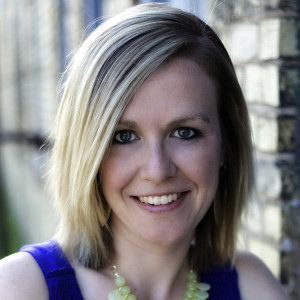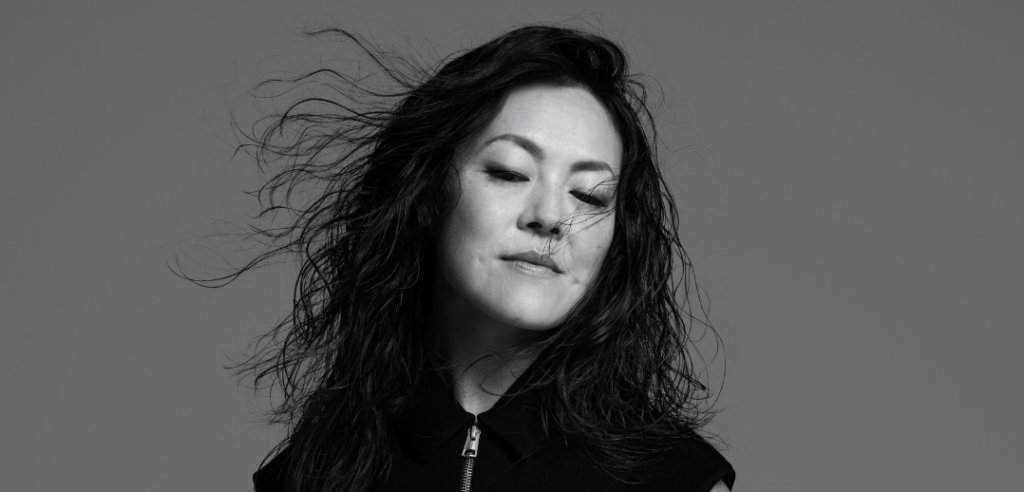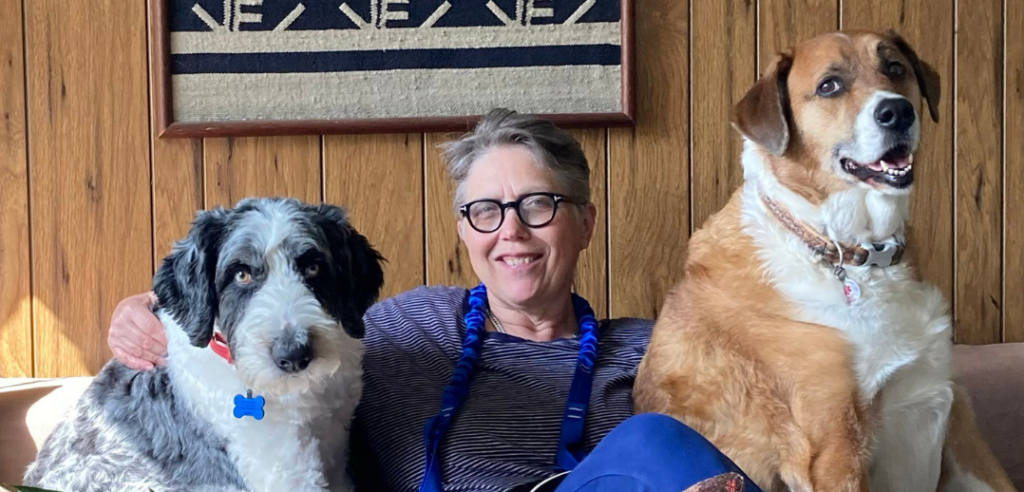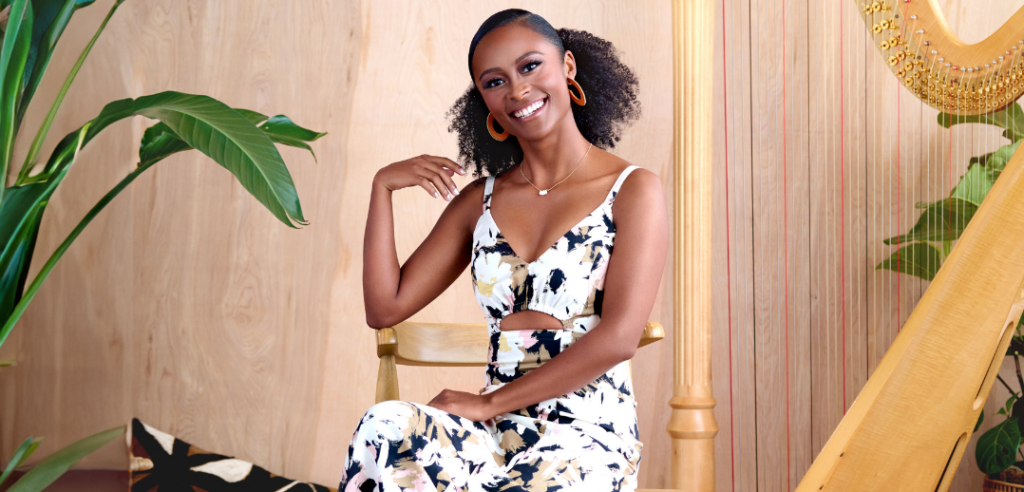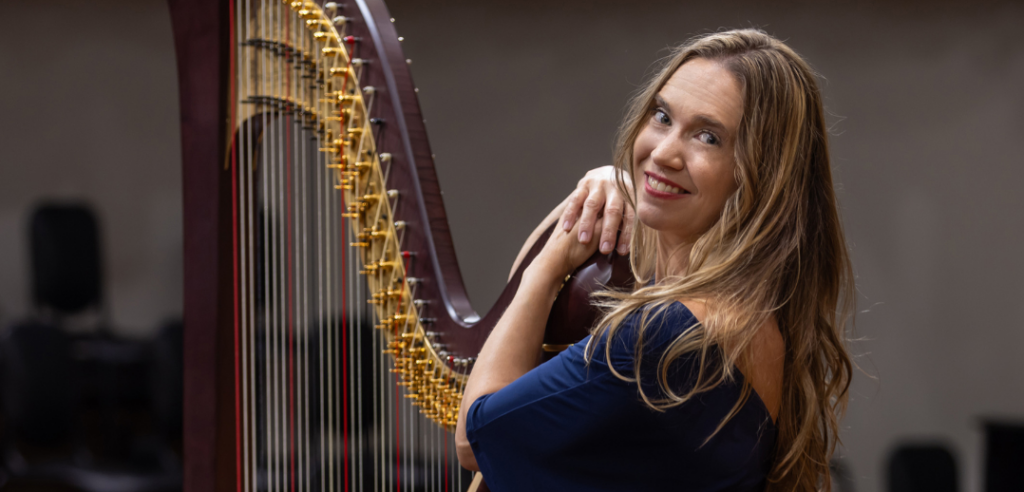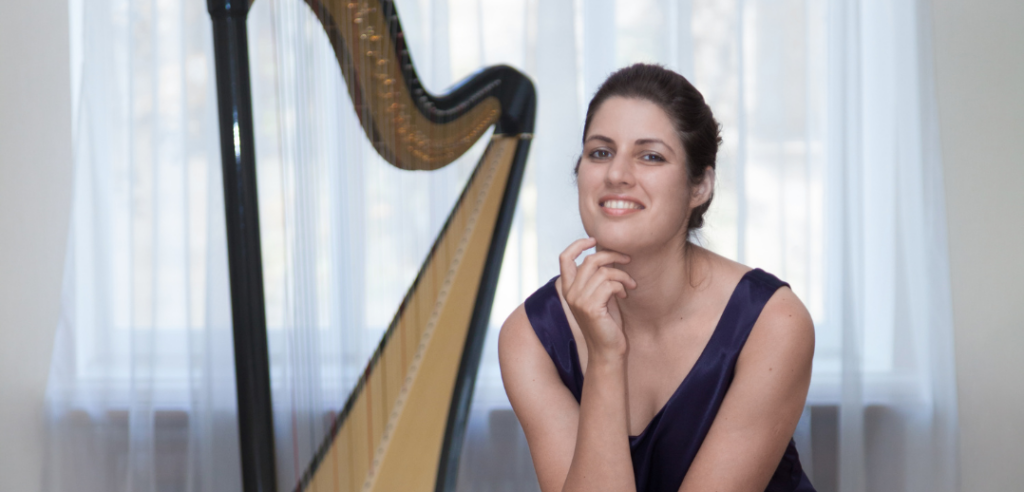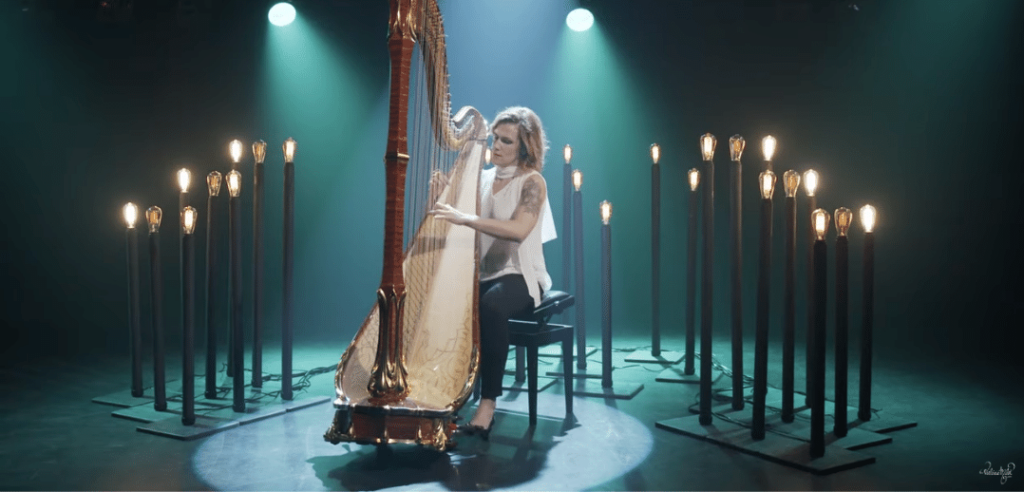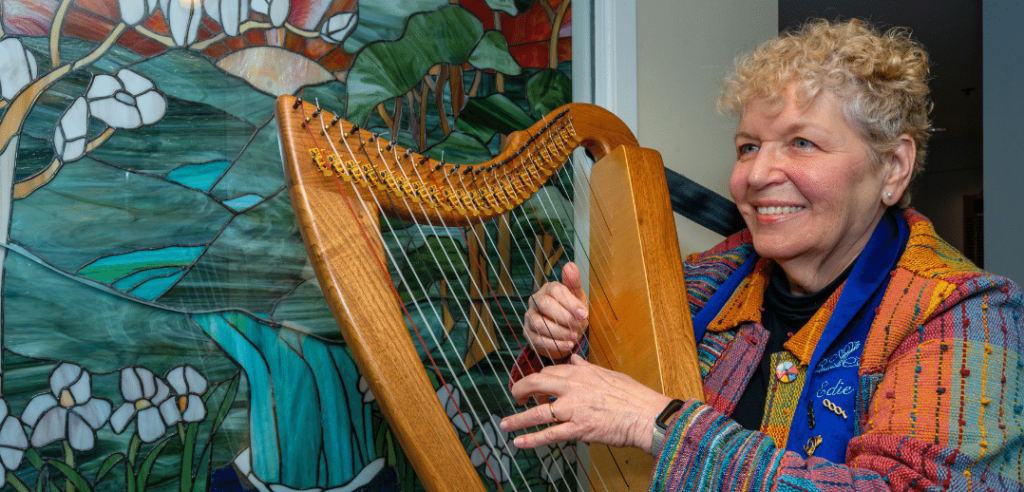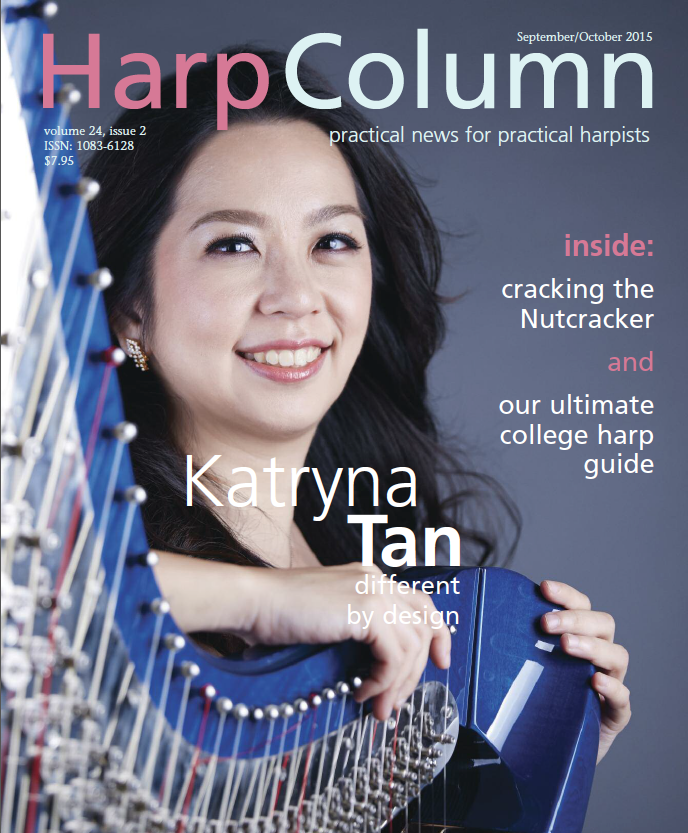Katryna Tan sees things. A harp musical. A career where people said there was no work. A sleek, modern harp center where her students could come to study and rehearse.
What makes Katryna different is that she doesn’t just see things, she does things, and she does them well. She quit her job as a successful architect to pursue the harp and hasn’t looked back. In the last 15 years she has built a vibrant career full to the brim with performing, teaching, and collaborating.
Katryna is not a household name outside of her corner of the world in Singapore, but when you hear what she is doing, you want to know more—and she’s always got something new cooking. I met Katryna back when I was an undergrad and she was getting her master’s degree in harp. Her unique combination of artistry, design, and drive make her a force to be reckoned with, though you would never know it by her short stature and disarmingly kind personality.
Katryna and I bridged the 12-hour time difference with a Skype conversation back in May. She was gearing up for the Singapore Harp Festival (held Sept. 4–6) and keeping up her usual break-neck pace of performing and teaching.
Harp Column: Tell us how you started playing the harp and your career path, because it’s not typical of most harpists.
Katryna Tan: That’s a long story! [Laughs] I started music when I was around 4 years old, I think on the piano first and then on the violin, and harp was my third instrument that I picked up around 9 years old. In between I played some Chinese instruments. My parents liked to expose us to art exhibitions and they loved music, so we were very fortunate, my sisters and I. We were having a holiday and we saw a harp and they decided to let us learn. I come from Malaysia originally, and at that time there were no harp teachers there. So I had to travel to Singapore, which at that time by older roads was six hours away by car. So when we started it was more like a hobby, just another instrument, and I liked it very much.
After that I went to Australia to pursue my bachelor’s degree in interior architecture. This was in Sydney at the University of New South Wales. I told my parents, “I think I still want to continue playing the harp.” And they said, “Well you have to study!” [Laughs] So they shipped the harp to Australia, and I found a teacher. I was very fortunate to find a teacher that was very good at sharing the passion of the instrument, and her name is Ulpia Erdos. I had lessons with her, and we had a good time. I had never seen a real harp concert until then. So I went to concerts, and she gave me opportunities as she said I was good enough to play in some of the orchestras there, so that’s how I started performing. I enjoyed it, and that’s where I found my passion, but I had to finish my degree. So I finished my degree, and I played in orchestras and in concert events in Australia.
When I finished my degree, I came back to Singapore to work as a designer, but I could not let go of the music. The Singapore Symphony Orchestra needed a harpist, so I freelanced for them and was juggling both jobs until one day I said, “Well, if I really want to do music, I have to do it now.” So I quit my job and I went for it. I managed to get a place in the master’s program at the University of Michigan, which was a blessing, and so I said, “Okay, I’m going!”
HC: So what was your family’s reaction when you said, “Hey, I’m going to quit my job as a designer and go study the harp?
KT: Well, they were not exactly pleased because I was doing quite good with my job, and it was something creative which I enjoyed too. My family was not so familiar with music as a career, so they were a bit hesitant and wondered how I would do. But I promised that I had a scholarship to study and could support myself, so they let me try it for two years and see how it goes.
HC: And obviously it’s worked out pretty well for you!
KT: Well, I think it’s been a great life, a great path to walk.
HC: So let’s talk about what you’ve built there in Singapore. How long have you been there?
KT: I’ve been living in Singapore for more than 15 years already.
HC: When you finished your degree in the U.S. and you went back to Asia, you decided to set up your career in Singapore. What made you choose Singapore over, say, your native country of Malaysia?
KT: Singapore is quite well off, and I had been working here for quite a few years already, so I was familiar with it. At that time, the orchestra needed a harpist, I had contacts who wanted me to perform, so that was a good starting point. I had an opportunity to stay in the U.S. for a doctorate, but I rejected it. It was a tough decision, but my main aim was to perform more and to share the harp with the people back here, because it was the same as when I started. There weren’t any harpists or harp teachers around. There were people who loved the harp but couldn’t learn. So that was something that was always in the back of my mind. I knew what I wanted to do when I came back—to share this beautiful instrument with everyone. And it has panned out quite well!
HC: I would say so! So let’s talk about your teaching, because I think it’s remarkable what you’ve built with your student group Rave Harps. You started it in 2004, is that right?
KT: Yes. So when I started playing the harp, I didn’t have the opportunity to see a harp concert or even play with a friend. It was just me and the four walls. After being in Australia and the U.S., I realized that playing in ensembles was really important in the education of students to let them grow. So when I started teaching, I decided to put them together to play, and they loved it! They became good friends and encouraged each other, and I think those are very good dynamics in a learning environment. So I continued to do that, and I think the students grew a lot just by having other opportunities to perform and to play together. So that’s how we started building.
HC: How many harpists do you have in your group today?
KT: Well, I have students everywhere—in Singapore and three towns in Malaysia—altogether, I think it’s around 100 or so.
HC: That’s fantastic.
KT: Yes, I didn’t think so many of them would study harp seriously, but I have about eight students doing harp professionally in this short time, so I think that’s pretty amazing. I don’t want to tell them not to, but I didn’t force them! [Laughs]
HC: They did it willingly! [Laughs]
KT: Yes, I think it’s a different time now where music as a career is more acceptable so it has changed.
HC: What is the music scene like in Singapore? Give us a sense of what it’s like to be a working musician in Singapore.
KT: Well, there are quite a lot of opportunities here. We have a lot of professional orchestras and lots of up-and-coming orchestras around, so there is demand. It’s a small island, but there is still enough to go around, and there are many, many concerts. So lots of people do concerts. And the schools are very encouraging. In Singapore, they try to encourage a well-rounded child, so the schools are very strong in encouraging students to do music and be in the band. Every single school has a band and a string orchestra. So that helps with the environment when everyone is trying to learn an instrument. It’s very nice, and it creates jobs for musicians to teach both in schools and privately.
HC: Obviously, with a hundred students, you don’t have time to teach everyone.
KT: No, no, no! I have other people who are teaching. It started small—I had students who were following me, and some who had studied elsewhere come to me. I did a lot of training for the teachers, and I designed a formal program to teach the beginning students. To maintain the standard, which I think is important, I do lots of masterclasses for the various groups at different times of the month, so I do know every single student and what’s happening with them.
HC: So yours is a private program—not part of the public schools—and you’ve developed your own curriculum, and then you, yourself, give masterclasses to students at different technical levels?
KT: Yes, that’s right. The masterclass is in a group setting, so that it is also an opportunity for them to perform for each other. It forces them to practice! [Laughs] It’s like how we did in university, you had to play for your friends. I start them young.
HC: How far away do you draw students from? How far away do they travel for lessons?
KT: Singapore is a small island, so someone can travel from one end to the other and it’s not a problem, but I do travel to Malaysia and have centers there. I fly there once in a while to do the masterclasses, but I have teachers who are taking charge of students there.
HC: Well, I have to ask you about Pluck because I have not heard of another original harp musical, but you created and directed this one. Where did you come up with this idea?
KT: It’s just crazy! I think I always loved musicals, and there was one time that I was watching all of this dancing and everyone started singing, and I thought, “Oh, it would be nice if they had lots of harps.” It was just a thought that came to me there. It was 2012, and I had taught for a while, arranged a lot of music, and traveled to many countries. I thought I had quite a lot of strong players among my students, and it’s such a waste if you have talented students and they don’t have a platform to show it, and this idea came up to try and do a musical. I wanted to do something more than just playing the harp so it would be more engaging for the audience. For the students, it’s a great learning platform because they learn how to perform, they learn where to come in, and also it’s something different.
HC: And how long did it take you from having this idea in your head to performance?
KT: About one year.
HC: How many harpists did you have involved in that production?
KT: We had, at the first one, around 25 or 30 harpists. We’re doing it again this year and there should be more.
HC: Are you doing the same musical or is it a different one?
KT: It’s a different one. It’s another adventure!
HC: But you are using the same character, right, because Pluck is the main character in this new production?
KT: Yes, she is still the main character.
HC: So it’s a sequel?
KT: Yes, yes!
HC: Now, you’ve written all the music for this. Do you rehearse the kids? Do they learn the music on their own?
KT: I think project management is a very important skill in doing this, and I think it comes from my architecture background. So I have to plan out the storyline, and then I have to have the music to match the storyline. Then I have to assign groups of students to learn different parts of the music, and I have to decide who can play what things. Most of the arrangements I have to do according to the levels of the students I have, so I have to know exactly who the performers are and what they can play. It’s a very complicated thought process. After I get the music, know the performers, and make all the arrangements, I have to make a very comprehensive and precise schedule of rehearsals, which spans the next few months. They will do a reading and then they will go back and practice, and I will encourage them to memorize—they all have to memorize it. Then we do the second reading, and they have to have it memorized, if not, they will get yelling from me! [Laughs]
HC: Katryna, I’ve never heard you yell in my life! [Laughs]
KT: I know, I know! [Laughs] So from the second reading you can get a gauge. I mean, sometimes you have to adjust to see what is possible to make it happen. Sometimes it’s too difficult and I have to adjust. So we’ll see how the second reading goes (for this year’s production). Then for the next few months we have scheduled rehearsals. So I will work on the music, and after they have that 100 percent, I will schedule time to have them work on their acting and how they come in and out. And then we have to do the harp movement during that as well.
HC: Right, there are so many moving parts to coordinate. It’s not just the music!
KT: Yes, and all this is just for the harpists. I still need to work on the lighting, on the costumes, on the stage, how it looks, the staging—so it’s a very complicated process.
HC: Given your background in design, how involved are you with the lighting and the set design and the costume design?
KT: I think because I can see all the things in my head quite well, I am able to speak some of my thoughts and then let them do their own thing, so I think in the end it’s a combination of both ideas.
HC: Right. So you must be getting ready and starting rehearsals for the sequel, because that’s going to be performed in September at the Singapore Harp Festival, which you’re also organizing, right?
KT: Yes! This is the fifth festival that we are organizing.
HC: When was the first one?
KT: 2006 I think.
HC: And you were behind this, you created it?
KT: Yes, the harp festival started because, like I said, I was trying to give the students more opportunities and I was very lucky that Isabelle Perrin was coming by Asia. We talked about it and she said she wouldn’t mind coming [to Singapore] and doing a masterclass and performing. So I said, “Okay, let me try to think of how we can do it.” We didn’t really have that many students then and the community wasn’t that big, so we said, “Let’s try to make it bigger so more people can learn about the harp.” That’s how I decided to do the first harp festival—to reach out to more people. Isabelle Perrin was the first international artist, and we wanted to have more international artists come in.
HC: You saw this as an opportunity to bring in international artists and give your kids exposure to that.
KT: Yes, but one thing that has been running through all the festivals is student performance opportunities. In every festival they must prepare something to perform, because I think, yes they learn from watching, but they also learn from the performance experience itself. So we showcase performances, and we always have a platform. You don’t have to be a professional to perform, so they get a chance to practice performing.
HC: Now I also saw that you’re starting a chamber competition for students this year.
KT: Yes, it’s the first time we’ve done this. People have been asking, “We need a competition; we need a competition,” so that’s what I thought of. There are so many solo competitions out there but not much chamber music being played, and it’s a different set of skills that musicians should learn. I think it’s challenging but it’s fun for them to do it.
HC: Yes, I thought that was interesting because this is for young kids too. You have two divisions, and the younger division is just age 12 and younger, and I know traditionally harpists aren’t playing chamber music when they are 10, 11, 12 years old.
KT: Yes, we like to start them young and open their ears to listen to other musicians and also to have a chance to work with others. Sometimes they work with their sisters and brothers instead of just playing on their own, so it’s a good way of encouraging it.
HC: Absolutely! How neat!
KT: I look forward to that because the students are excited. Some of them are not sure how to get together, so we are giving them guidance, and I’m looking forward to it!
HC: A lot of people have great ideas, but few people actually take those ideas and execute them, and even fewer people are able to take those ideas and make them happen over and over and over again like you’ve done with your festival, with Rave Harps, with your musical. You don’t just have these good ideas and do them, but you do them again and again and make them better. How do you think you make that happen? What are the skills you have that make that happen?
KT: I don’t know! [Laughs] I am lucky to have a set of students who are really good. I see them doing a concert, and it’s amazing, and I feel that if I don’t continue doing it, their interest will drop or their talents will be wasted, so that’s why I keep thinking of something new! It has to be different every time so that they learn new things. I think it’s also challenging and good for me to keep my creativity going.
HC: Where do you come up with your ideas? What inspires you?
KT: Sometimes I go to concerts and musicals and come out with ideas. I travel and see something and think it’s really nice. For example, I was appointed to do something in Tasmania: the Harp Island Project. I was teaching some students there, and it was eye-opening to me because the harpists, many of them are like 60 or 65 years old and many of them drive for hours with cars or wagons carrying their harps. They play and they are so motivated and they say it’s like brushing their teeth, they do it every morning. When I look at our own elderly community here, I find that they are not doing anything, and these are such motivated people. So even that inspired me to start a harp program to encourage older students. So after that I came back and started an adult program. It’s nothing special, it’s just classes to encourage them to learn the harp, it’s such a beautiful instrument. You don’t have to be an advanced player to enjoy it.
HC: Interesting. So what keeps you motivated to keep up this level of creative production?
KT: I think I enjoy seeing the end result! [Laughs] And I enjoy seeing people grow from it. I think every student, even myself and my staff, they grow from every project, we learn something new, and I like seeing the growth. That’s very satisfying. There are students who have followed me through all the festivals and competitions and I see how they’ve gone from a blank sheet of paper to improving their sound and becoming more professional.
HC: On top of everything else, you wrote a book last year, right?
KT: It was the end of 2013, I think. I wanted to write it mainly because my teaching career has come to a point where I’ve seen lots of results. I’ve gone through lots of hardships, and I’ve trained many students, and I want to share this experience with other students or parents or teachers. When I first started to teach, I didn’t know how to teach. It was trial and error, and you try your best, and you learn on the way what the music journey is like for a child and for a teacher. Lots of patience is needed. Sometimes it’s good to know in advance, so that was the reason I wrote it. And I was very proud of my students and wanted to dedicate that book to those students.
HC: Tell us a little bit about your Rave Harps Center that you opened earlier this year.
KT: We always had a place, it was just a smaller set-up, and rehearsals were really tough because we were squeezing in so many harps and hoping that nobody knocked over any of the harps, but we managed. But I thought it was time that we get more space to rehearse, number one, and number two I wanted a chance for the students to perform even in an informal setting like a little hall. I also wanted a space for guest artists when they come. So we found a little place, more like a proper, more formal school.
HC: Great! So how many kids on a weekly basis? Do they have their lessons here on a weekly basis? How many are coming in and out through your doors each week?
KT: In Singapore it’s about 60.
HC: And then in Malaysia do you have a dedicated building?
KT: It’s a studio. I train a lot of teachers, and they do manage to do it quite independently.
HC: What do you think is the single most important thing in your harp training that has helped you succeed in your career?
KT: I think in my training I learned it’s all about relaxation—how to get a better sound, how to get ease of playing, how to play musically—relaxation is the main thing. Second, I learned there’s not one perfect way of playing that suits every single harpist. Every child is different, their hands are different, their physiology is different. I think keeping that in the back of my mind is very important because then I approach every student with an open mind. And I think that helps, because I communicate with them better. I see their problems easily or their strengths or their weaknesses, and I accept that everyone is different, and I try to work on the different parts. I think that is very helpful, because the student feels that they are understood.
HC: You went to a place where there was very little in terms of a harp scene and built this very vibrant career. What advice would you have for harpists who are early in their career who are looking to find their niche and start their careers somewhere?
KT: I think that it is good for them to ask themselves inside what do they really like to do. I think I did some soul-searching myself on what I really wanted to do, what do I enjoy doing, and what my strengths are. I mean, not everyone likes to perform on a big stage solo. Some like chamber music, some like solo. Some people can play well but they prefer to teach. Some people like to compose. There are different ways. You mentioned that I started in a place where there were hardly any other harpists, I think that was a challenge. People asked me when I decided not to do the doctorate, “What are you going to do in Asia? There are no harp jobs for you.” But I think my background as a designer has trained me to think in terms of designing what you want to do. I know in my mind what I would like to do and what I am capable of, so I pursue it and I have to trust myself that I can make it happen. So you design what you want to do, and that is what I have been doing.
HC: If you were not playing the harp today, what would you be doing?
KT: I would probably be designing beautiful skyscrapers! [Laughs]
HC: What advice would you give your younger self from your life’s experience so far?
KT: Trust in yourself, believe in yourself, and work hard. I think you have to have a very clear vision of what you want to do, even if you do not know how to do it. Many of the things I did, I had no idea how to do it. For example, I wanted to do a musical, and so I found a way to do it. If you start looking, answers will come to you. But if you don’t look, it won’t happen. •










